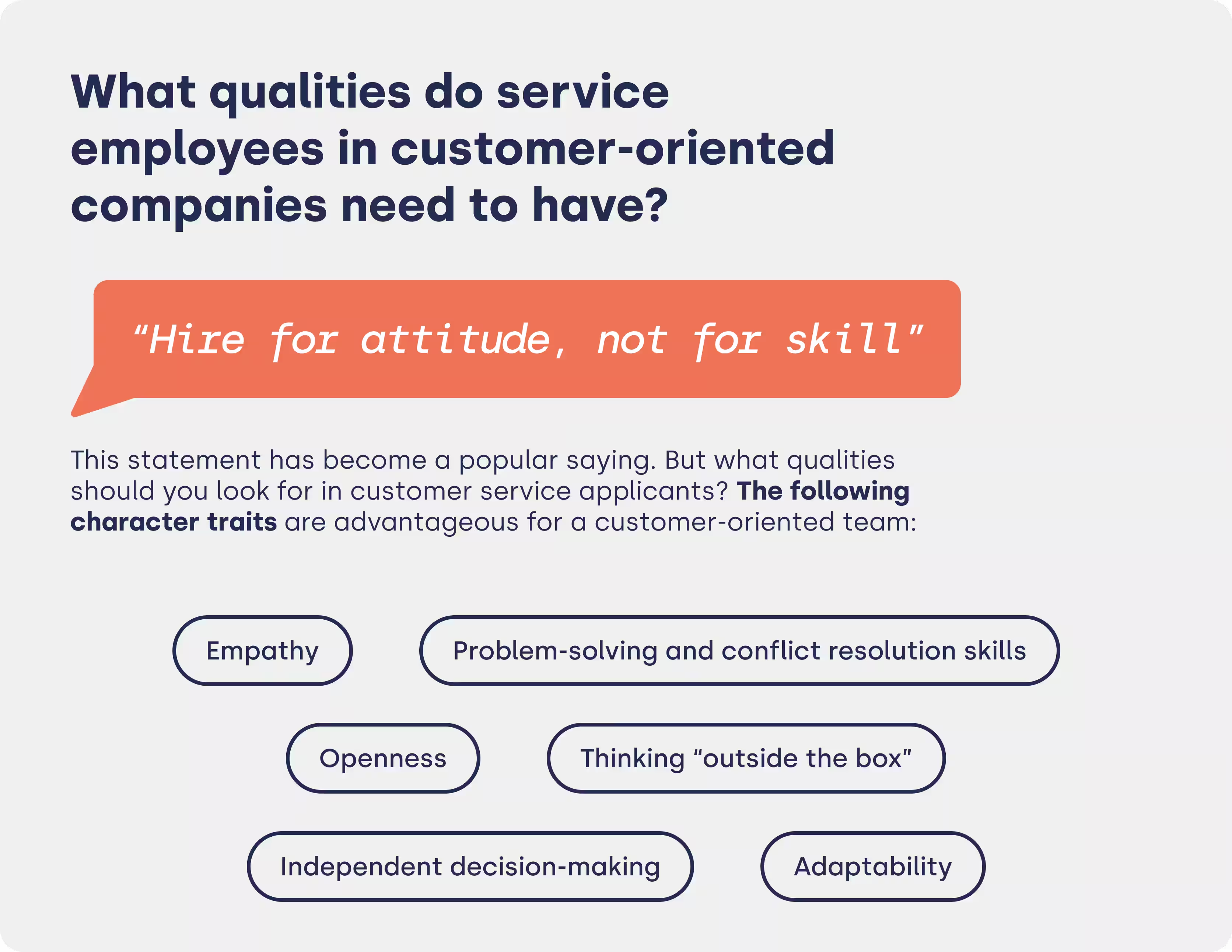Definition: What is customer focus?
Customer orientation describes the strategic orientation of a company and its decisions, processes, and communication tools towards the needs and expectations of its customers. A deep understanding of customer needs forms the basis for long-term relationships and trust, creating sustainable business success. What does this mean in concrete terms? Supporting customers in every situation and delivering personalized and holistic results. Standardized, off-the-shelf solutions have no place here. Personalized communication with information tailored to the customer is paramount.
Anyone who deals with customer-oriented companies quickly realizes that they are not just interested in short-term, quick profits but that they genuinely care about their customers. The customer is not just a means to an end in order to make a profit. The motto "The customer comes first" is truly lived out.
This is because customer-oriented companies know that they can only be successful if they place the customer at the center of all their activities and consistently pursue this focus.
Examples of customer-oriented companies
What can customer orientation look like? There are no fixed criteria for this — depending on the company's sector and customer needs, it can have very different facets. Let's look at two examples of companies:
1st Zappos

The US e-commerce company specializes in fashion and shoes — and in consistent customer orientation. Zappos is convinced that customer service can build close relationships between employees and customers. For Zappos, the focus is on a central need of their buyers: that someone takes care of their concerns. And the friendly and emphatic service staff satisfy this need.
But it doesn't stop there: Zappos employees have the freedom to go the extra mile for customers — even completely outside the actual range of services. This can also mean that a service agent orders a customer a pizza when he asks him about it at the end of the chat.
2nd Patagonia
The outdoor clothing company focuses on sustainability and environmental protection. This attracts customers who care about exactly that and are willing to spend more money on quality products that last a long time. One of the customer requirements is therefore longevity. That is one of Patagonia's quality promises.
But what if something does break? Where other companies would be more likely to rely on generating new sales through repeat purchases in the case of broken or worn clothes, Patagonia is choosing a different path. In doing so, they meet customer expectations and remain true to their mission:
With their “Worn Wear” initiative, they partner with their buyers to repair, share, or recycle clothes. In tutorials, they teach the community how to repair their clothes themselves. The company also allows them to resell their used Patagonia clothes on the official website or exchange them for a voucher at Patagonia stores.

How can companies behave in a customer-oriented manner? 8 tips
Various factors within a company are important for establishing customer focus. Employees, corporate culture, and management all play an important role. We have eight tips on what you can do in these areas:
- Listen to your customers and collect feedback: This can be done, for example, through surveys or short satisfaction polls. But you can also gather valuable feedback, suggestions, and ideas from your customers on social media.
- Stay in touch with your customers and be available: Make it as easy as possible for them to contact you. You should use various channels such as the classic hotline, email (even personalized if necessary), social media, and innovative tools such as chatbots.
- Set goals based on customer feedback: Customer feedback will certainly reveal areas where you are performing worse than planned. Take the feedback seriously and set specific goals to achieve improvements.
- Build a community around your products and topics. This will make customers feel well cared for and that they belong. Maintaining the community is very important and contributes to customer loyalty in the long term.
- Give your customer support team the freedom to resolve most customer issues independently and perhaps even take unconventional approaches. Employees should also have the opportunity to suggest changes to management that would benefit customers in the long term. After all, they are closest to the consumers.
- Treat your employees as your most valuable asset: Whether they enjoy going to work has a major impact on how they respond to customers. Satisfied and committed employees work more efficiently and have a more positive attitude towards customers. Your customer service team should consist of people who enjoy customer inquiries, are happy to help, and are committed. You can also teach certain technical skills through training.
- Offer first-class training: Ideally, you should train your entire team in your customer-centric approach. Teach them what customer focus means for your company and what values are important to you. Offer customer-focused training. In these sessions, your team should learn who your customers are, how they use your product, and how you can meet customer needs. Ideally, they will then know how to resolve complaints easily and efficiently and how to provide personalized and empathetic customer service. Through cross-selling (i.e., offering complementary products or services), the company demonstrates that it anticipates customer needs and offers suitable solutions.
- Management must support customer focus: Otherwise, the approach cannot work; for example, if the Zappos employee had been criticized afterward for ordering pizza. Management must also exemplify the corporate culture and values associated with customer focus.

Customer orientation goals
Customer-focused companies have one key goal: to satisfy their customers' needs and thus retain them for longer. But why go to the trouble of ordering pizza for customers, for example, when it's not part of the business model? Or launching worn wear initiatives? Quite simply, it's more expensive to acquire new customers than to retain existing ones.
Companies have to spend a considerable amount of their budget on marketing measures to persuade new customers to buy. On average, the cost of acquiring new customers is between five and seven times higher than the cost of retaining existing customers!
It is therefore essential for companies to provide quick and helpful support to customers through direct contact and to offer coordinated products and services that guarantee an individualised and customer-oriented customer experience. What's more, the more satisfied customers are, the more likely they are to recommend the brand to others. Referral programmes also play a supporting role here. So customer focus also attracts new customers.
What are the success factors for customer orientation?
As mentioned at the beginning and as the two company examples show, customer focus can take many different forms. But there are a few general success factors:
- Make excellent customer service a central part of your company mission and align yourself strategically with a customer focus.
- Connect your entire company through customer-oriented values and make these values present within the company (e.g., through internal campaigns).
- Give all employees experience with customer contact. For example, each team member could spend a certain amount of time working in customer service or, if applicable, in branches.
- Create a central tool for your customer data and avoid different departments maintaining their own Excel lists. When all data is collected in one place, it is easier for customer service to look after customers, and customers feel understood and are more satisfied.
- Create a corporate culture based on trust, giving employees the confidence to make independent decisions in the interests of customers.
- Use various communication channels to convey to customers that they are the focus of attention. Examples of customer loyalty measures include newsletter updates and loyalty rewards.
- Use the feedback received by customer service in product development and process optimization.
Conclusion: Build a loyal customer base through customer orientation
What do you need to know about customer focus? Here are the key points at a glance:
- In this approach to business management, customer needs take precedence over those of the company.
- Customer-focused companies put the customer at the center and deliver personalized and holistic results.
- The central goal is to satisfy their customers' needs and thus retain them for longer.
- Customer loyalty is an essential success factor and offers both the customer and the company great added value.
Friendly and empathetic employees with problem-solving skills play an important role in customer orientation. However, the corporate culture should also be geared towards this, and management must support and exemplify this approach.The customer service team needs the freedom to find and implement customer-oriented and out-of-the-box solutions.










